by Editor | Aug 4, 2014 | New Articles, Restaurants
Article and photos by Josette King
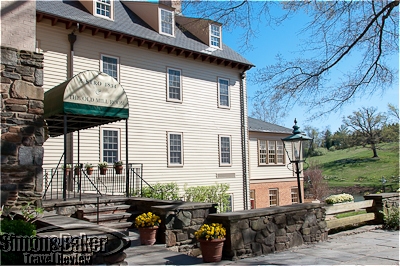
The Old Mill Room restaurant was located in the historic part of the property
The Old Mill Room is a restaurant with a distinguished past and a cuisine grounded in the present. Located in the historical core of the Boar’s Head in Charlottesville, Virginia, it was built from a valued piece of local history, the repurposed timber from an abandoned 1834 gristmill famous for having survived the Civil War and gone on to operate a whole six decades after it. Moved piece by pieced from is original site on the banks of the Hardware River, it was integrated in the construction of an inn’s main building in the early 1960’s.

The shaded central lawn of The Boar’s Head evoked of a town common of old
The décor of the restaurant had been designed to showcase those striking architectural details while creating a refined environment that evoked timeless southern grace. It was an ideal setting for the elegant classic cuisine with a Virginia flair and international contemporary touches dished out by Bill Justus, executive chef, and his team.
At the Old Mill Room the building was not the only custodian of a proud history. When Chef Justus joined the Boar’s Head as executive chef in 2010, he took over a restaurant with the singular distinction of being the longest holder of a AAA Four Diamonds designation in the Commonwealth of Virginia.
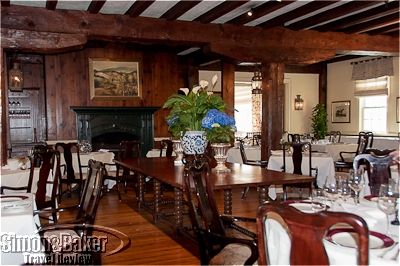
The historic Old Mill Room was built from the timber of an abandoned 1834 gristmill
Justus maintained the award winning culinary excellence while bringing to the menu the lighter dishes, farm to table freshness of local ingredients and imaginative flavor and texture pairings I appreciated. At the time of my visit, the Old Mill Room had been awarded once again its Four Diamonds, for the 27 consecutive time.
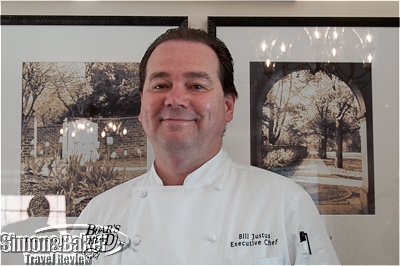
Executive Chef Bill Justus
From the amuse bouche of chilled watermelon with goat cheese mousse to the perfectly caramelized creme brulee, my meal was a shining example of the creativity that went on in the kitchen. My appetizer skillfully balanced the sweet tenderness of exquisitely seared scallops with a light crust of smoky ancho chili pepper and bitter cocoa. As for the sunburst trout filets of my main course, they were dusted with blue cornmeal and served with a colorful accompaniment of tiny black Peruvian potatoes and Atlantic lobster succotash, and a discrete dash of Pernod in the light lobster sauce. It was interesting and delicious.
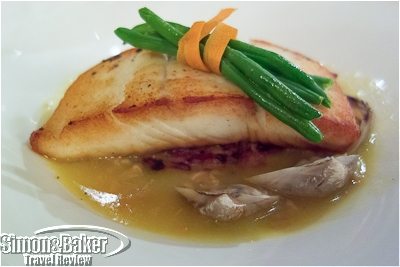
Pan seared halibut with steamed clams in a light saffron sauce
It stands to reason that my local friends regard the Old Mill Room as one of the greater Charlottesville area de rigueur places to celebrate special occasions. I will plan to return myself, the next time my travels take me back to Central Virginia.
by Editor | Jul 7, 2014 | Accomodations, Ecotourism, New Articles
Article and photos by Josette King
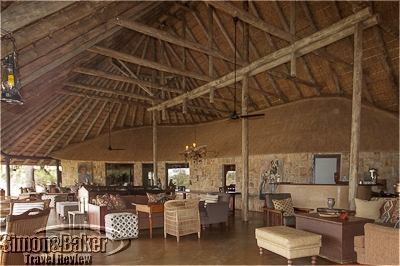
The lounge was an eclectic mix of safari antiques, rustic furniture, local crafts
On my first visit to Southern Africa a decade or so ago, my very first guide predicted: “Once the red dirt of Africa gets into you hiking boots, you will never get it out.” Now, a couple of pairs of boots later, I understand what he meant. But, the power of iron saturated clay dust notwithstanding, what keeps me going back is that every so often on those safaris, I come across an exceptional guide who can make the wonder of the natural world come alive, someone like Hearold Mgiba, the guide I had the good fortune to meet on my recent visit to Motswari Private Game Reserve in South Africa.
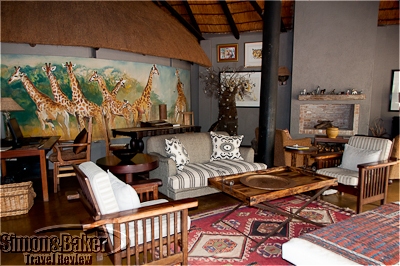
The library and art gallery
Wedged in the northern corner of the famed 54,000 hectare (209 square mile) Timbavati Nature Reserve, one of the oldest and most pristine in South Africa, and with an open boundary with Kruger National Park, Motswari is reputed for its density of game. The Big Five (buffalo, elephant, leopard, lion and rhino) roam there. So I expect it would have been relatively easy for Hearold and Difference Hlophe, an excellent tracker, to ensure that I enjoyed what is considered the gold standard of African safaris: repeated Big Five sightings. And I did enjoy those, daily. But one hour into our first drive, I was beyond counting. We were driving into thicket so dense I didn’t imagine we could possibly get through it, much less see anything of note, tracking a leopard. Hearold and Difference knew their big cats and found the one they were searching for in the end, concealed in the rocks near a water hole. We followed it around its territory to the tree where it had stashed its recent impala kill.
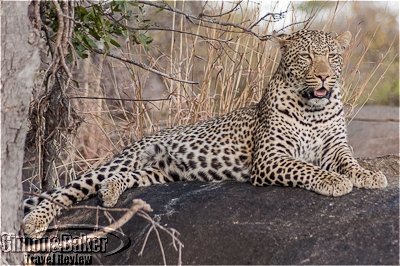
A large male leopard surveys its domain
The next morning found us among leopards again as we watched an old male go in the blink of an eye from snoozing in the high grass to snarling menacingly from the top of a 20 meter (65 foot) tree at his nonplussed pursuer. In fact, in my three days at Motswari, I was able to observe at length and at close range more leopards than I had seen in all of my previous visits to Africa. And there were also lions: a fascinating interaction between two males feeding on the carcass of a buffalo calf, and a whole pride going about its daily business; and elephants, a large breeding herd of them on the move with nursing calves; and mud encrusted rhinos crashing their way out of a water hole; and cheetahs on the prowl, and a whole supporting cast of mammals and birds. And in most instances, these weren’t mere sightings but unique opportunities to enjoy an authentic bush experience.
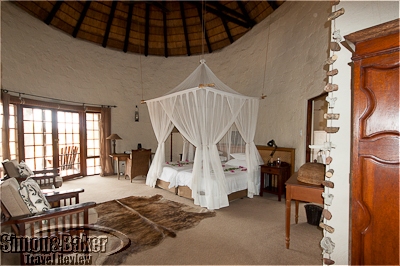
My Bungalow was decorated in relaxing neutral tones
The lodge itself reinforced this feeling. With its neat guest room rondavels scattered in a mature grove along the river, the homey atmosphere of its public areas and its large boma for dinners around the flames of a central fire pit, Motswari had the feel of a family country estate. I especially enjoyed the relaxed simplicity of my airy rondavel, with the creature comforts and modern amenities I could wish for in the bush, such as a king size bed under a romantic white netting canopy, mission style armchairs with thick canvas cushions, a good writing desk and chair, a sunny modern bathroom, ceiling fan and air conditioning, and round the clock electricity with plenty of outlets to recharge my electronic equipment. Returning there after long, exciting game drives, I appreciated all the more that Motswari had eschewed the edgy chic and flamboyance that has become a trend in recent years and sometimes gives me a sense of disconnection from the wilderness.
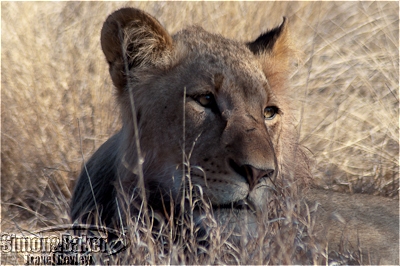
There was a large resident pride in Motswari
Beyond creating a welcoming haven for its guests, I also valued Motswari for its ongoing commitment to nature conservation and responsible tourism, which has been the guiding principle of the Geiger Family since it acquired the property three decades ago. From the onset, the original owner, the late Paul Geiger, focused on wildlife conservation and environmental management, and on creating employment and growth opportunities for the local communities; thus practicing the key tenets of responsible tourism and sustainable development long before they were articulated by the international community.

A rhino was caked with mud after a visit to a water hole
In recent years, Motswari has been repeatedly recognized for its achievements in that arena, such as its ongoing accreditation by the prominent Fair Trade in Tourism, South Africa (FTTSA), a distinction the property first earned in 2008. In early 2013, Motswari also achieved Gold Class status on the Heritage Environmental Certification Program (based on internationally recognized sustainability and responsible business initiatives), making it the only environmentally certified lodge in Timbavati. I especially appreciated the property’s concern for its people. Over and again its policies set the stage for responsible tourism. There appeared to be no gender discrimination for any position. Individuality and initiative were encouraged and acknowledged with a wide range of recognitions from Employee of the Year to Most Valuable and Most Popular and Best Dressed (staff members were given the opportunity to design their own uniform).
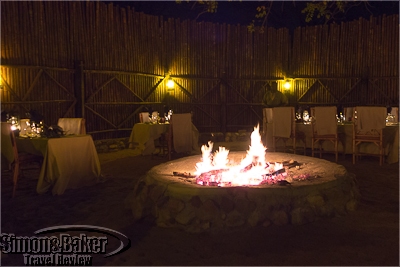
Dinner was served in the boma
Because the property was located deep into the reserve, it was necessary for all staff members to live on site. The family friendly staff village included accommodations for visiting spouses. I enjoyed hearing about some of the success stories, such as that of Godfrey Mathebula who grew up on the property and started out in the maintenance workshop. When he became interested in tracking and guiding, Paul Geiger sponsored his education. Mathebula went from guide to head guide to assistant general manager. In 2012, he was nominated for South Africa Guide of the Year.
Motswari also reached out to the community at large. As well as supporting local (Hoespruit) organizations with donations, the property had designated staff members to work with these organizations on issues of basic healthcare, nutrition, HIV education and testing. I left with the impression that the property’s responsible tourism ethos created a tight knit community among the management and staff of Mostwari, and an all around friendly atmosphere that directly influenced the exceptional quality of my bush experience there.
by Editor | May 12, 2014 | Accomodations, Ecotourism, New Articles
Article and photos by Josette King
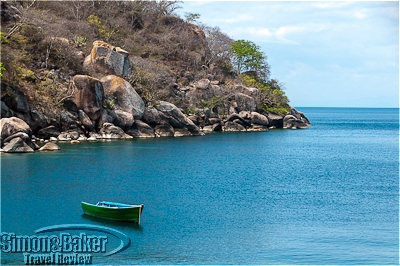
The view from my tent at Mumbo Island
When I first heard of Malawi, in the earliest days of my love affair with Africa over a decade ago, I confess that I had to consult an atlas to locate the small landlocked country wedged into the southern end of the East African Rift Valley. Less than 900 kilometers (560 miles) from north to south and barely 160 kilometers (100 miles) at its widest, Malawi was overshadowed by its much larger neighbors, Tanzania to the north, Zambia and Mozambique to the south, east and west. It was, and remains as of this writing, mainly unnoticed by international tourism travelers. Yet this narrow strip of rugged terrain carved by the Great Rift Valley is rich in spectacular vistas and home to several national parks, and of course Lake Malawi, known by the most passionate divers and water sports enthusiasts. It is the third largest of the African lakes, and for some arguably the most beautiful.
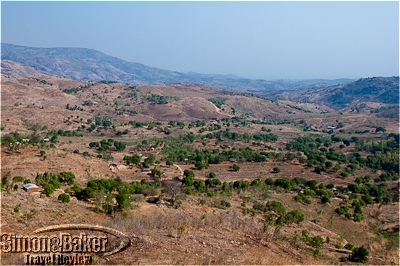
Great swaths of the country were used for subsistence agriculture
It is also one of the poorest countries in Africa, and one for whom the development of a viable tourism industry is an important growth and indeed survival factor. It was this opportunity to have it all, to visit, and through that support a country in the early stages of modern development as well as enjoy a safari off the beaten track, and experience a remote tropical beach environment known by many in the region, but rarely visited by international travelers, all within a few hours’ drive that made Malawi an irresistible destination for my most recent African visit.

The shores of Lake Malawi were dotted with fishing villages
Reaching Malawi had its challenges. With a population of 16 million living mainly in rural areas, and an economy largely based on subsistence agriculture, it is one the least developed countries in Africa, with only the most rudimentary national infrastructure. And what of the tourism infrastructure? I needn’t have worried. A few forward thinking properties have established themselves in recent years, ranging from unabashedly off the grid to luxury class, in the most desirable tourism destinations in the country. Each had a unique personality that was just right to ensure optimum enjoyment of it surroundings. One constant however, throughout my visit to the peaceful little country was the warm welcome of the gentle people of Malawi.
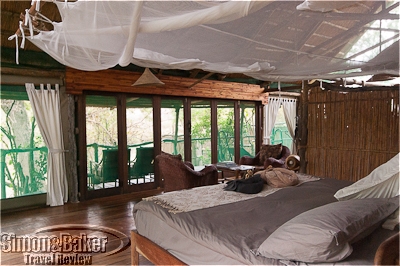
The king size bed at Mvuu faced the deck and the bush
From a luxury safari perspective, Malawi is for people who want a bit of real world authenticity with their posh African safari.
Mvuu Lodge in Liwonde National Park, considered the premier park in Malawi for its large population of hippos and elephants and its abundant bird life, offered intimate wilderness tented accommodations with a casual atmosphere and the creature comforts I have come to expect from a luxury safari property. Ideally located at the edge of a secluded lagoon across the Shire River from the park entrance, it could be reached only by boat. The open sided main area was raised high into the trees for a sweeping view of the constant wildlife activity along the lagoon. The riverside location allowed for a mix of cruises and drives that provided a close and varied view of the game as it went about its daily life. The highpoint of my stay was a perfect morning on the river, when we came across a bachelor herd of elephants, one of them sound asleep (yes, elephants can sleep laying down), then spent a memorable hour watching their antics as they horsed around in the middle of the river like teenagers at the beach.
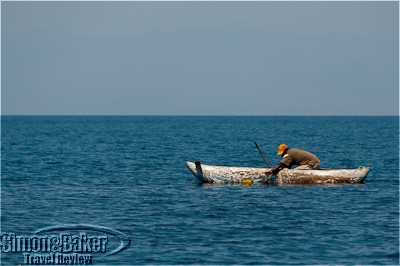
A local fisherman casting his net from a dugout canoe
Some 580 kilometer (360 mile) long, Lake Malawi is the main topographic icon of the country. It is internationally renowned among water sports enthusiasts and naturalists for its pristine shores and deserted islands nestled between towering boulders rising straight from crystal clear waters alive with small brightly colored fish. The beauty of the scenery and the hundreds of endemic species of cichlids fish drove the Malawi government to set aside the southern end the lake as Lake Malawi National Park in 1980. It was the first fresh water marine reserve in the world, and then in 1984 it became a UNESCO World Heritage Site.
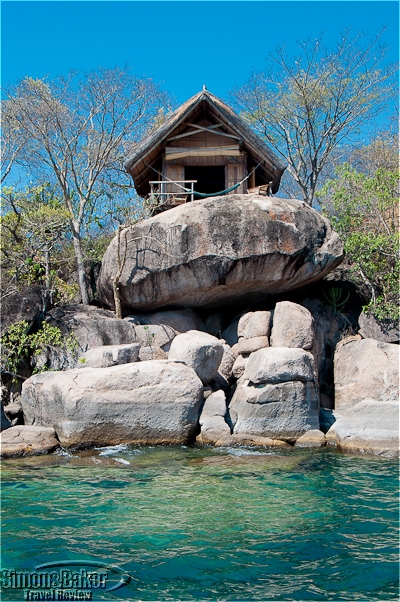
My tent was a reed and thatch bungalow high above the lake
An hour’s motorboat ride off shore from Cape Maclear, Mumbo Island was a pristine one square kilometer (250 acres) dot of granitic rock topped by lush miombo woodland and blessed with a crescent beach of golden sand. Until the National Parks authorities first awarded Kayak Africa the exclusive rights to operate tourism accommodations on the island in 1996, it had never been populated. To preserve its unspoiled beauty, Kayak Africa created Mumbo Island Camp, a minimalist property run on uncompromising sustainable principles. It consisted of rustic bungalows of reed and thatch with comfortable beds, bucket showers and “eco-loos,” perched high in the rocks to better admire the dazzling waters of the lake, a dining area that served wholesome, simple foods, and in a corner of the beach, a water sports gazebo. There was no electricity, just solar and paraffin lamps and wind up flashlights. What did I like best? The dawn wake up call of a red billed hornbill enthusiastically welcoming the sunrise, and snorkeling in warm waters so clear I could see the outlines of underwater boulders deep beneath me, bright cichlids darting about them, and kayak rides to watch the sun dip into the lake, and… well, everything. The ultimate luxury of Mumbo Island Camp was its very existence.
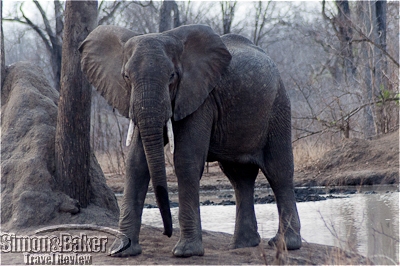
Elephants were a common sight at Mkulumadzi
Mkulumadzi, the sole property in Majete Game Reserve, the recently reborn only Big Five game park in Malawi on the Lower Shire River; and Pumulani, on the western side of the Nankumba Peninsula at the edge of the Lake Malawi National Park, were sister properties designed for Robin Pope Safaris by G. Hooft Graafland, a Dutch architect. These innovative world class luxury lodges sat gently upon the land, each guest accommodation custom designed to fit into the topographic elements of its environment, and covered with a roof of endemic vegetation to help offset its own carbon footprint and regulate inside temperatures.
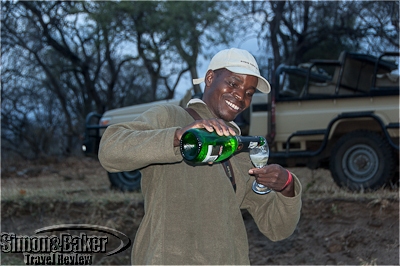
Samuel Chihana pours a sundowner drinks for us
While the properties had their distinct character best adapted to their purpose, both were decorated in an elegantly understated contemporary style that offered optimum comfort without ever distracting from their breathtaking surroundings. Each had its own trademark feature. At Mkulumadzi, the wilderness lodge, it was the impressively engineered 88 meter (290 foot) suspension foot bridge that led across the river to the property’s entrance. It never failed to deliver new game viewing opportunities and make me feel like an explorer of a bygone era.
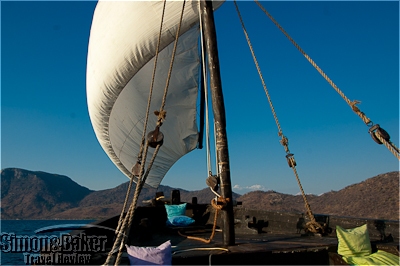
The traditional dhow sailed around the lake
At Pumulani, the lakeside beach lodge, the unique feature was the authentic, hand built wooden dhow with a triangular sail, reminiscent of the days when Arab traders plied the waters of the lake, always ready to take me on a breakfast or sunset cruise. And best of all, along with exceptional memories I took away the satisfaction to have experienced two properties in harmony with my responsible tourism ethos.
But that was no surprise. On one of my early visits to Zambia many years ago, I had the good fortune to meet Robin and Jo, the founders of Robin Pope Safaris. It was a conversation that went a long way to opening my mind to the power of responsible tourism as a tool for sustainable development in Africa and beyond.
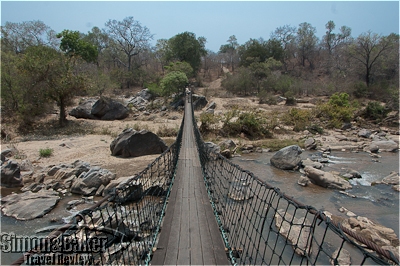
The lodge was reached via a suspension footbridge over the Mkulumadzi River
These two premier properties, relatively recently opened in a country still in the early stages of development were an ideal opportunity to experience first hand the contribution that the presence of my fellow tourists and I were making to the protection of previously at risk wilderness areas, while helping to alleviate poverty through good local employment practices, and the involvement of the local communities. I was delighted to hear that Pumulani was recognized as Malawi’s leading hotel at the 2011 and 2012 World Travel Awards.
by Editor | Jan 13, 2014 | Accomodations, Luxury Travel, New Articles
Article and photos by Josette King
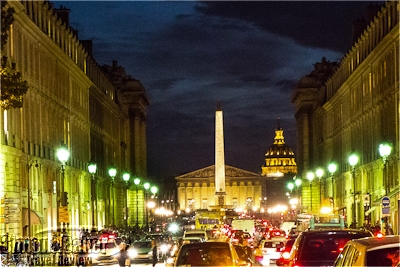
Rue Royale and Place de la Concorde at night.
Although I am a regular visitor to Paris, it had been years since I had set foot around the Rue Royale, the short street that runs between Place de la Madeleine and Place de la Concorde, within the posh Right Bank enclave where the first and eight arrondissements meet. There, Rue du Faubourg Saint-Honore on one side, and Rue Saint-Honore on the other, share a directory of addresses that represent the Gotha of French and international haute couture. Then just around the corner, Place Vendome is home to some of the world’s most renowned jewelry houses (Cartier, Van Cleef and Arpels, Boucheron, Chaumet et al.).
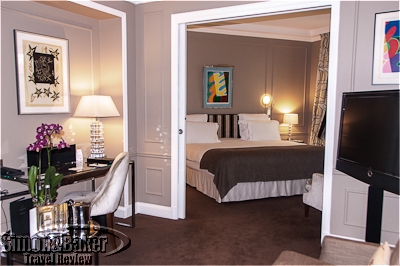
The bedroom of the Opera Suite.
Being of one mind with Lady Windermere (“I can resist anything but temptation.”), I suppose I instinctively felt it best not to venture too far into this bastion of enticing luxuries until my recent stay at Le Burgundy, a five star boutique hotel that opened in 2010 on Rue Duphot, just off Rue Saint-Honore.
Originally, the winning argument for my choice of Le Burgundy was its in house spa, complete with 15 meter (50 foot) long swimming pool, hammam and sauna, a rarity among boutique properties in Paris.
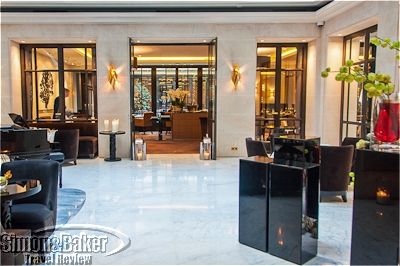
The winter garden opened onto the dining room.
That it had already garnered a solid reputation for the luxury of its accommodations and excellence of its service had only faintly registered in my awareness, until I checked in. From the warm welcome of the doorman who relieved me from my bulky carry on bag before I had even made it through the front door to the reception staff who had me settled in my suite in record time, the tone was set. The service was attentive and unobtrusive every moment of my stay.
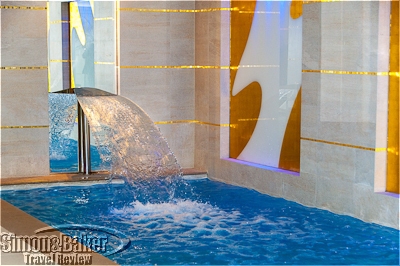
There was an arching waterfall at the far end of the pool.
My spacious second floor suite, Opera, (the eight suites were named after some of the most iconic nearby landmarks) was an intimate urban retreat decorated in an understated classic style with contemporary touches and the latest modern amenities. I especially enjoyed the vast bathroom with its top of the line whirlpool bathtub and oversized walk in shower with high pressure rain showerhead and six moveable body jets. And then, for the ultimate Parisian apartment luxury, the bedroom’s French doors opened onto an inviting private terrace surrounded by large tubs of lush shrubbery.

Place Vendome was only a few minutes’ walk from Le Burgundy
It was a pleasure to relax there between marathon visits at the nearby Musee du Louvre and Galerie Nationale du Jeu de Paume, a museum of contemporary arts.
And yes, I did enjoy window shopping around this chicest of Paris neighborhoods every time I stepped outside Le Burgundy. But beyond its privileged location and excellent accommodations and service, it was the unique indulgence of starting each day with an invigorating swim followed by a scented eucalyptus and citrus steam bath that propelled Le Burgundy to the top of my favorite Paris addresses.
by Editor | Dec 9, 2013 | Attractions, Ecotourism, New Articles
Article and photos by Laura Scheiber
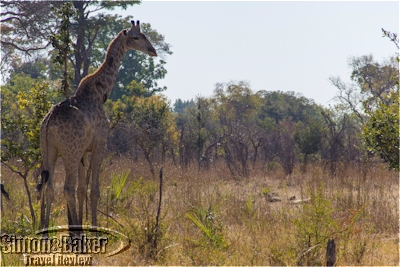
A giraffe keeping vultures away from her baby
For me, an ideal vacation includes a little rest and relaxation mixed in with adventurous activities. Perhaps this was why my stay at Tongabezi Lodge along the mighty Zambezi River in Zambia was so memorable. On the day of arrival at this luxury lodge, I met with Quentino Mbingi, the director of activities, who invited me to choose from a handful of activities ranging from the adrenaline pumping thrill of sitting on the edge of Victoria Falls to relaxing on a sunset boat cruise on the Zambezi River with sundowners. Quentino efficiently put together an itinerary that allowed me to partake in all of my preferred activities during my three day stay. Most activities were included in the room rate, along with meals, and drinks. Some activities offered by outside companies were available for an additional fee.
On my first day, I enjoyed a two hour sunset cruise on the beautiful Zambezi River. Four other guests and I hopped into a small motor boat on the dock at Tongabezi with Captain Victor, a soft-spoken friendly man who pointed out the many birds we observed along the bank. We meandered around a small island in the middle of the river, and Captain Victor positioned our boat within a few feet of crocodiles sunbathing on the sandbar. Without warning, one of the big crocodiles splashed in the water at lightening speed. I had quite the adrenaline rush. I would have felt scared if I hadn’t been in such good hands.
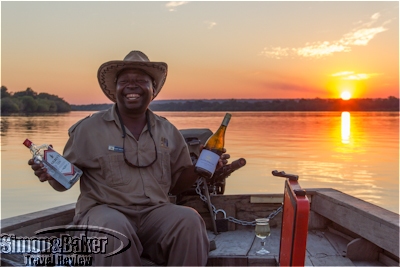
Captain Victor serving up sundowners
While stopping for sundowners in the middle of the river and watching the magnificent sunset, Captain Victor explained that he was a well-known crocodile hunter who had caught hundreds of crocodiles in his lifetime and set them free further down river away from human populations. I liked hearing his fascinating stories about crocodile (and snake) hunting while drinking a refreshing South African Sauvignon Blanc on the Zambezi River.
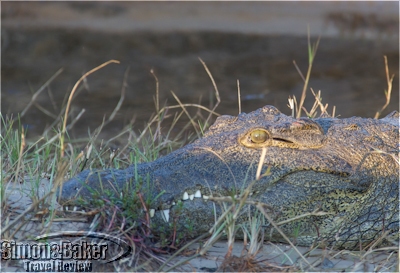
A crocodile sunbathing on the river bank
The next day I went on a private game drive in Mosi-Oa-Tunya National Park, the second smallest in all of Zambia, and roughly 20 minutes from Tongabezi. I had hoped to see a rhinoceros since it was the only one of the Big Five that I had not seen during previous safari adventures in Zambia. My private gaming guide, Fabias, provided clear and interesting explanations of the animals we saw while stopping anytime I wanted to take pictures. Most memorable was when Fabias spotted a number of vultures flying high in the sky. He drove to where they were circling and a few minutes later, he spotted a giraffe in the distance herding a bunch of vultures on the ground. Curious to find out what was going on, he drove closer to the giraffe where we eventually saw a young giraffe that had died sometime within the previous 24 hours, according to Fabias. Though sad, we couldn’t help but watch the mother giraffe valiantly try to keep the vultures away from her baby.
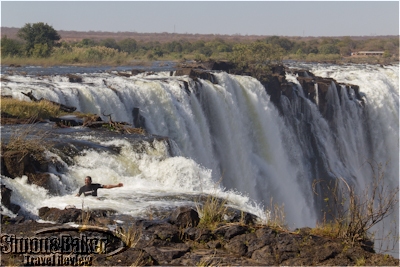
My guide demonstrated where I should sit at the edge of the falls
After a two-hour game drive, Fabias drove me to the five-star Royal Livingstone Hotel where the management of Tongabezi surprised me with a complimentary gourmet lunch and tour of Livingstone Island, which departed from the Royal Livingstone. I, along with seven other guests, was chauffeured by motorboat to the island where, our tour guide, Collins, took us on a five-minute walk to the side of the island facing Victoria Falls. He offered wetsuits to those of us interested in sitting in the natural pools in the Zambezi River on the edge of the Falls. Our fearless leader walked us toward the edge that had a heart-pounding drop of 100 meters. The views were spectacular and we were treated to a double rainbow. Collins carefully led three of us, one by one, into the water where we sat about 15 feet away from the edge of the Falls. Scary? Yes. Exhilarating and unforgettable? Absolutely. After such an adrenaline pumping experience, we were served a delicious lunch of fresh green salads, couscous, fresh tilapia fish, grilled vegetables, and a sweet bread pudding as a dessert. A South African white wine went well with the fish.
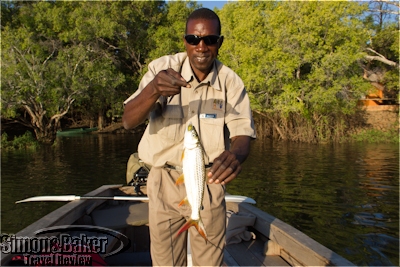
The tiger fish I caught with Fabias
After we returned to Tongabezi, Fabias prepared a small motorboat for my private fishing excursion. It was a lovely late afternoon with ideal temperatures and a cloudless sky, perfect for a relaxing boat ride on the Zambezi River. Fabias patiently showed me how to work the fishing rod and explained Tongabezi’s catch and release fishing policy. Within minutes, I felt a tug on my fishing line and excitedly reeled in a tiger fish. Fabias took care of the not so pleasant task of unhooking the fish. Throughout the trip, I enjoyed sundowners of my choice and opted for a refreshing South African Sauvignon Blanc. The hour and a half fishing trip ended with a beautiful sunset. At the end of a day full of activities, I was pleasantly surprised to find a bottle of sparkling wine in a bucket of ice, and a candlelit hot bubble bath waiting for me in my room, compliments of Tongabezi.
My final river adventure was a private canoe trip. Quentino, a certified river guide, went over the safety rules and helped me into a small canoe, while Captain Victor was in a motorboat ahead looking out for crocodiles and hippos. Quentino welcomed me to paddle, but made it clear that it was not necessary if I preferred to relax and take in the tranquil scenery. After crossing the river towards the Zimbabwe side, Quentino pointed out a number of colorful birds that were fishing along the riverbank. On our way back to Tongabezi, we canoed through some reed-covered islands where hippos were resting on sandbanks about 50 feet away from us. It was exciting to be so close, but I was happy to keep a distance, as I knew how fast hippos could move. Between Captain Victor and Quentino I felt in good hands, as both had had years of training and experience as river guides.
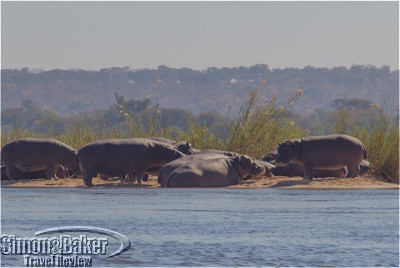
Hippos sunbathing during my canoe trip
The only downside of my stay at Tongabezi Lodge was that it ended too soon. The location of this luxury lodge was ideal. Just 40 minutes upstream from the hustle and bustle of Victoria Falls, the lodge was close enough for activities associated with the UNESCO world heritage site, while far enough to explore the Zambezi River. Having an activities director who customized my itinerary added a personal touch that set Tongabezi apart from other lodges. The service was top notch and I plan on returning someday to partake in the activities I did not include during this first visit.
by Editor | Nov 11, 2013 | Accomodations, Ecotourism, New Articles
By Laura Scheiber
Photos by Matthew Harris
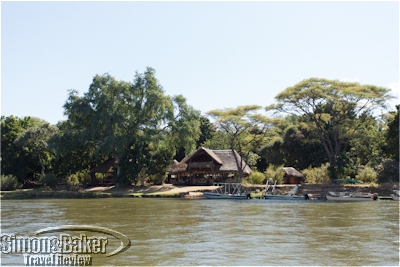
Chiawa Camp
My husband and I had high hopes that Chiawa Camp, a tented property in Zambia‘s Lower Zambezi region, would provide us a premiere safari experience based on the property’s awards and recognition. Soon after our arrival we discovered the camp, situated on a picturesque riverbank in the Lower Zambezi National Park, offered outstanding game viewing, luxury camp accommodations, and excellent cuisine and service. We also learned that Chiawa had another side. Its founders, Dave and Grant Cumings, a father and son team, participated in the fight against poaching. While staying at the camp, we had a chance to chat with Grant about how it all began.
Back in the day, Dave used to take his son Grant on bush trips, exploring east along the Zambezi River. Eventually they arrived at Chiawa’s current location and found themselves going back for repeat trips. Sleeping under the stars and surrounded by amazing wildlife and geography, they believed the spot to be a magical place, and wanted to share it with others. They started taking friends and family on trips to the area. In time, the practice evolved into photo safaris with diplomats living in Lusaka. Through some convincing and lucky contacts, the governmental parks department awarded Dave and Grant a permit to build a semi permanent camp in the Park.
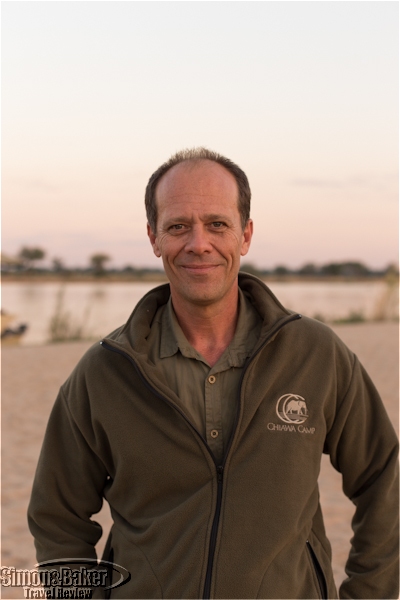
Grant Cumings, co-owner, Chiawa Camp
At first things were difficult. Zimbabwe is just on the other side of the river, and the civil war saw a lot of guerrilla activity in the region long before Chiawa’s existence. Soldiers from both sides would frequently fight on the Zambian side of the river. Eventually the conflict ceased, leaving a number of former soldiers in possession of firearms. With few opportunities to earn an income, many turned to poaching. Grant spoke poignantly of seeing his first butchered elephant as a young man, something that moved him deeply and motivated him to fight passionately for conservation.
The Cumings father and son team started to move against poachers, working with scouts to track, capture and turn them over to the authorities. It was dangerous work. To their dismay they uncovered evidence of corruption, which strongly suggested that some officials were in collusion with the poachers. On one occasion, Dave brought in a detective from Lusaka to break the poaching ring. A number of poachers were found and captured, and used rifle shells were gathered as hard evidence of poaching activity. However, the day after capture a detective said the shells had mysteriously been misplaced.
It quickly became apparent to them that the poachers had bought him off. Dave thought quickly on his feet, and in a moment of inspiration, responded that losing the shells was no problem since he had some extras (which wasn’t true). That tricked the detective into thinking that the prosecution would go ahead. During a tense showdown, the detective “found” the missing shells and the prosecution was able to proceed.
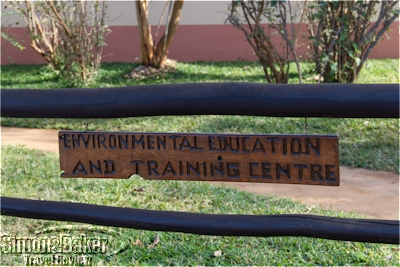
The Conservation Lower Zambezi Environmental Education Program
At the height of poaching, Grant and his team might come across 60 to 70 mutilated elephants each year, whereas now they might come across six to seven carcasses in the bush, most of them from animals that had died of natural causes. Grant and his father realized that capturing poachers was only half the story, education was also key. If poachers and the children of poachers could be made to understand that keeping those beautiful animals alive was worth more in the long run than killing them, then conservation efforts would be sustainable.
Through a serendipitous meeting with a Danish ambassador who drove into Chiawa Camp one day, Grant was able to secure Danish sponsorship and establish the Conservation Lower Zambezi Environmental Education Program.
A residential center, he explained, it strives to provide a wide variety of conservation and HIV/AIDS education to Zambians from all over the country. It also hosts the rigorous guide certification exams. The program, he said, has provided career opportunities for many locals, some of whom now work as guides at Chiawa. Grant explained that although poaching remains an ongoing battle to this day, it has significantly declined in the region thanks to the efforts of the Cumings family members and park scouts, and subsequently through Conservation Lower Zambezi, a charity they co-founded and of which Grant is a trustee and past chairman.
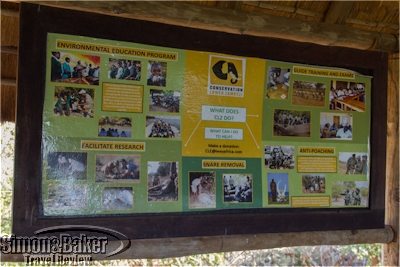
A bulletin board at the Conservation Lower Zambezi facilities
Grant’s conservation efforts are not yet done. His dream is that one day the black rhino might be introduced back into the Lower Zambezi National Park. He’s resigned to the fact that this isn’t possible just yet because they would present too tempting a target for the poachers. His hope is that over time this will change, through continued education and anti-poaching efforts.
It was a pleasure to meet Grant, an inspirational pioneer of conversation in the Lower Zambezi region. While we thoroughly enjoyed our luxury safari experience at Chiawa, what made it special was understanding firsthand the ethos of conservation that is so intricately intertwined in the history and current practices of the camp. We hope to one day return and see its continued conservation efforts evolve to preserve the natural beauty of the Lower Zambezi National Park.













































